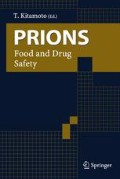Abstract
Autophagy is a degradative mechanism involved in recycling and turnover of cytoplasmic components, including organelles. Eukaryotic cells have two major protein degradation systems; one is the ubiqutin-proteasome system, the other is lysosomal mechanism. Proteins can be transported to lysosome following at least four pathways; endocytosis, macroautophagy, microautophagy and chaperone mediated-autophagy. Autophagy (macroautophagy) is mediated by an autophagosome, a double membrane organelle containing undigested proteins and damaged organelles. Autophagy is associated with several pathological conditions including neurodegenerating diseases. One of the main pathological hallmarks of neurodegeneration is loss of neurons. Apoptosis was reported in several neurodegeneration diseases to be not high enough to account for the loss of neurons so autophagy was thought to be involved in neurodegenerative processes. We studied the ultrastructural signs of autophagy in prion diseases: in brain biopsies from Creutzfeldt-Jakob disease and fatal familial insomnia patients and in experimental scrapie in hamsters. Our biopsy material consisted of brain biopsies obtained by open surgery from 1 fatal familial insomnia case, 1 case of variant Creutzfeldt-Jakob disease, 7 cases of sporadic Creutzfeldt-Jakob disease and 1 case of iatrogenic (human growth hormone) Creutzfeldt-Jakob disease as well as brains of hamsters inoculated with the 263 K or 22C-H strains of scrapie. For electron microscopy, approximately 2 cubic mm samples were immersion fixed in 2.5% glutaraldehyde for less than 24 hours, embedded in Epon and routinely processed. Grids were examined in a transmition electron microscope. In many cells a large area of the cytoplasm was transformed into a collection of autophagic vacuoles of different sizes. Autophagic vacuoles formed not only in neuronal perikarya but also in neurites and synapses of all categories of studied human transmissible encephalopathies and in experimental animals. Autophagic vesicles developed also within dystrophic axons. On a basis of ultrastructural studies, we suggest that autophagy plays a major role in transmissible spongiform encephalopathies and may even participate in a formation of spongiform change.
Access this chapter
Tax calculation will be finalised at checkout
Purchases are for personal use only
Author information
Authors and Affiliations
Editor information
Editors and Affiliations
Rights and permissions
Copyright information
© 2005 Springer-Verlag Tokyo
About this paper
Cite this paper
Sikorska, B., Liberski, P.P., Giraud, P., Kopp, N., Brown, P. (2005). Autophagy is a common ultrastructural feature of neuropathology of prion diseases. In: Kitamoto, T. (eds) Prions. Springer, Tokyo. https://doi.org/10.1007/4-431-29402-3_41
Download citation
DOI: https://doi.org/10.1007/4-431-29402-3_41
Publisher Name: Springer, Tokyo
Print ISBN: 978-4-431-25539-0
Online ISBN: 978-4-431-29402-3
eBook Packages: MedicineMedicine (R0)

